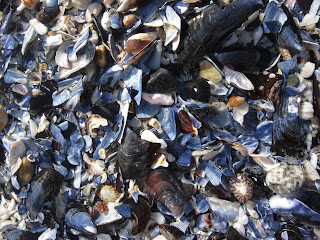After spending the morning and early afternoon at the top notch Kirstenbosch National Botanic Garden, we headed south toward the Indian Ocean beach community of St. James as this was our last full day in Cape Town. On the way, we detoured to Pollsmoor Prison, not the place we would normally want to visit under any circumstances! We wanted to stop at the entrance, though, for a few minutes to contemplate that one of the greatest men of the 20th and 21st century spent some time at Pollsmoor.
The lure of the beach was strong so on we we drove until we reached St. James, located in False Bay about halfway between the city and the Cape of Good Hope.
Many of the homes in St. James dated back to the time when the Cape was a colony of the Victorian empire. St James is named after the St. James Roman Catholic Church, built in 1858 for the Filipino fishermen of Kalk Bay, just up the road.
St. James was once the place of the rich and famous from the country's gold and diamond days but now it is better known for its small beach with its colorful picture-postcard beach huts and tidal pool. It was an image of those 'bathing boxes' in a tourist brochure that drew us to St. James.
Funded by the local municipality. local businesses and the Save Our Seas Foundation, the program also hired spotters to scan the waters off popular swimming beaches for signs of sharks. The program provided much needed jobs and income to members of low income communities.
We had no need for the delightfully adorable huts at the far end of the beach as we hadn't brought our swimsuits with us in the car.
The saltwater tidal pool was a big draw for kids playing in the shallows, jumping off the side and end as well as the 'more mature folks' swimming laps!Passenger trains rumbled by every ten minutes or so on their way to and from Cape Town and Simon's Town, the town near where we'd seen so many African Penguins a few days previously that was only a few miles south of James Beach. Years ago, we used to hear trains near where we live but the area has since been so built up, the trains' distinctive sound is only a memory. As a result, we always love and seeing trains when we're on the road.
We learned a couple of years ago to always pack bubble wrap with us even though space in our duffel bags is at a premium.
With the mountain backdrop, we couldn't have asked for a more picturesque scene for our last getaway to a beach for a good while.
It was late afternoon before we dragged ourselves away from the beach and back toward the city along the two lane road that paralleled the beach. I pitied the poor commuters from St. James as the traffic barely moved.It worked out perfectly for me as I was able to hop out of the car and take some photos of some famous homes. The humble Rhodes Cottage was named for Cecil Rhodes, one of the richest men in the world in his time, who spent his last days there. If you read the posts on Zimbabwe, you may remember that Rhodes shaped southern Africa like no other individual; he had two countries, which he virtually owned, named after him and he was a colossus in the diamond industry.
Just a quick hop from Rhodes' abode was a row of buildings steeped in history. One of them was Yokohama, a small homestead that was imported in sections from Japan. It was unique because it was made out of paper and has stood there for over 100 years, defying all the 'Cape of Storms' has thrown at it! The latter name for the Cape was coined by the Portuguese explorers.
Steven was still stuck in traffic so I was able to admire, very briefly, the Casa Labia Cultural Center, just up the street. Built in 1929 to reflect the spirit of 18th century Venice, Casa Labia, now a national monument, was a former residence of Count and Countess Natale Labia. It was turned into "an upmarket venue, complete with a modern art gallery, clothing shop and Italian cafe."
We got back to Altona Lodge (above), our home away from home for almost a week in Cape Town, after 6:30. We were so relieved we had picked such a perfect place for us to stay: the location was ideal with its being just minutes from downtown and the waterfront; Peter, the owner, and Wendy, his assistant manager were delightful and helped with whatever we needed; our room and wifi were ideal; we had full use of the kitchen to cook something quick and easy after long days seeing the sights; and the price was very reasonable! If we're ever lucky enough to return to Cape Town, we'd sure want to stay there again.
Next up: Visiting wineries around Cape Town before jetting off to Dubai!
Posted on February 12th, 2016 from Littleton, Colorado.












































No comments:
Post a Comment
We love to hear from you!!!!